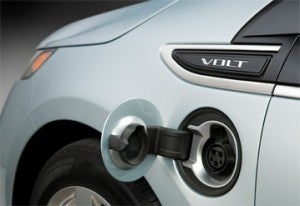By: Jamie Fine, EDF Economist, and Colin Meehan, EDF Clean Energy Analyst
Last Friday’s move by General Motors (GM) to briefly suspend production of the Chevy Volt must not be misconstrued as a sign that the car is failing to advance American leadership in building a clean energy future.
Just a few short years ago, it was widely argued that America’s vehicle manufacturers could never again be healthy competitors in the global marketplace. They simply lacked the vision, discipline, and innovation skills necessary to re-invent themselves, it was said.
Today, many of those same doom-sayers are again selling American manufacturing short. GM blames those critics for the pause in Volt production, saying they have treated the car as a “political lightning rod.”
GM has a point. With Volt production by its 1300 Michigan employees slated to resume in April, the critics are missing the real story behind the Volt and other electric vehicles in production and under development. That is the story of steady and determined progress toward American leadership in building the clean, reliable, safe and sought-after vehicles Americans want to buy. With that progress comes the promise of new jobs, a cleaner environment, and reclaimed pride and competitiveness of America’s manufacturers. For GM, the Volt symbolizes the company’s technological prowess in its most profitable year ever.
Lost in the gloomy rhetoric about the Volt is some genuine good news: the Chevy Volt and Nissan Leaf are actually beating the sales history of their hybrid cousins. When the Toyota Prius and Honda Insight were offered as the first commercially available hybrids in 2000, only 9,350 cars were sold. By the end of their first year, over 17,000 Nissan Leafs and Chevy Volts were sold. This is a particularly impressive debut considering the headwinds they have faced in terms of negative publicity and technological hurdles.
The Prius is now among the best selling cars in the U.S. with over 2 million vehicles on the road. Most major auto manufacturers now offer hybrid vehicles, from Buick to BMW to Hyundai. The same can be said for electric vehicles (EV) today.
Fueleconomy.gov, the “official U.S. government source for fuel economy information,” lists 16 new models coming out over the next few years and another six models planned for limited release and testing. Ford, Honda, Toyota and Mitsubishi have new electric or plug-in hybrid models coming out this year, with Ford and Toyota each offering two new models this year.
Innovations in EV technology, production economies of scale and rising gasoline prices continue to improve the value proposition for EVs. In just one example, an important breakthrough announced by GM-backed Envia will reduce the cost of EVs most expensive component–the battery–while extending driving range.
Electric vehicles can be fueled by almost anything, from wind and solar to natural gas power, which makes them possibly our greatest asset in any effort to reduce our dependence on foreign fuel supplies. For all the increased oil production in the U.S. over the past few years, our domestic supplies remain a drop in the bucket compared with our consumption.
Electric vehicles aren’t just about saving money or achieving energy independence. A number of recent studies, such as the latest from Lawrence Berkeley National Lab, find that vehicle electrification is a necessary part of any meaningful strategy to fight climate change.
Fortunately, the future for electric vehicles remains bright. But don’t believe us, just ask the automakers. “Most major auto manufacturers have announced their EV and/or PHEV production plans, which add up to 0.9 million units by 2015 and about 1.4 million units per year by 2020,” wrote Lew Fulton Senior Transport Analyst at the IEA.
Whatever politically motivated attacks may be aimed at EVs, and whatever shortcomings these revolutionary new vehicles may display, one thing is certain: the move to EVs represents a rebirth of confidence in American innovation, workers, and competitive manufacturing. It also marks an irreversible national commitment to building a cleaner, more fuel-efficient transportation system for a prosperous American future.











One Comment
Of course the politicians don’t want us having EVs… They’re all getting their pockets lined by Big Oil and the oil lobby. You figure those 12,000 Volts and Leafs… They’re using an average of $2000 less gas/year. Just on those 12,000 EVs alone, we’re using $24M less in gas per year. Creep that up to 50K cars or 100K cars, and then 25-50K cars/year, and you see the absolute hurt-lock Big Oil will be in! And as more gas cars are taken off the road, replaced by EVs, the losses will climb. What we should have, like the Cash For Clunkers during the recession, is EVs for Guzzlers, and swap out gas hogs for EVs. Trade in a gas car, and get an EV/EREV/PHEV, and get an instalnt $5K rebate at the dealer. And, similar to what’s done in the UK, when a guzzler is traded in on an EV, it is recycled – not resold. Point is to get it OFF the road and KEEP it off the road!
So… Who do you REALLY think is behind the Volt bashing?